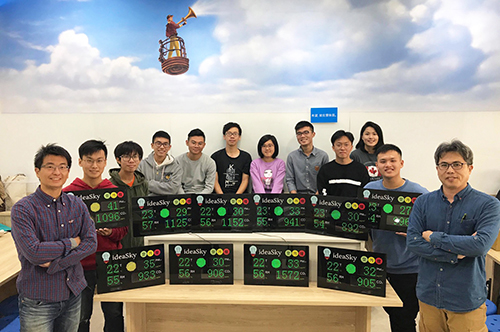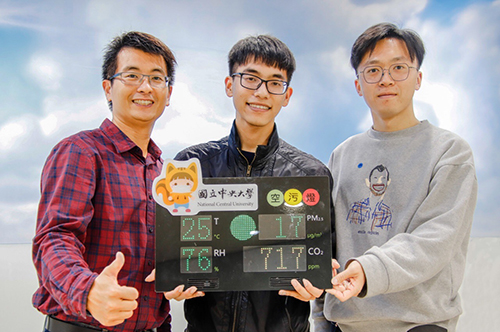Protecting the Public Health: “Air Quality Monitor” Developed by Research Crew at Department of Atmospheric Sciences

The “air quality monitor” was developed by students led by Dr. Sheng-Hsiang Wang, Associate Professor at the Department of Atmospheric Sciences of National Central University. This device can detect fine particles such as particulate matter less than 2.5 µm (PM2.5) and carbon dioxide (CO2) concentration with the visualization function. It is a simple but powerful device. It also provides a user-friendly interface for the general public. In the near future, the team will explore the applications of the device in Southeast Asian regions.
The prototype of the air quality monitor originated from the “air quality flag”. In 2016, Dr. Wang led students of a Service Learning course to raise air quality flags in the sports field of the NCU campus. The color of flags indicated the air quality of the day, providing useful information to folks on whether the air quality is good for outdoor activities. In recent years, Dr. Wang delivered creative interdisciplinary courses, instructing students to integrate knowledge and skills of mechatronic engineering, computer science, environmental engineering, and atmospheric sciences. Through the courses, Dr. Wang, together with students, completed the development of the “air quality monitor,” which has an important implication for practical teaching experience and university social responsibility.
Throughout the project of the “air quality monitor,” from preparing for raw materials, welding, cropping, assembling, appearance design, to the backend database and webpages, all the processes were handled by students. One of the key components of the air quality monitor is called Aerobox, which is a datalogger performing data recording, data saving, and calculations. The advantages of this system include low power consumption, high accuracy, and full support of customization. Currently, the air quality monitor was installed in several places on the NCU campus. In addition, few health care and medical institutions purchased the monitor for education and research purposes.
「
In addition to the installation of “air quality monitors” in public space, the research team plans to expand the home application. Once PM2.5 or CO2 concentrations go beyond the set standard, users may have a standard operating procedure for reducing exposure. The team is approaching the concept of the “Internet of Things (IoT) for Air Quality,” collecting the data acquired from many local devices, using big data with scientific knowledge to explain data, and expanding its outreach. The goal of the team is to keep people away from PM2.5, an invisible killer in the air.

The “air quality monitor” was developed by students led by Dr. Sheng-Hsiang Wang, Associate Professor at the Department of Atmospheric Sciences of National Central University. It is a simple and user-friendly device. The team is working on product marketing and is outreaching to Southeast Asian regions.



